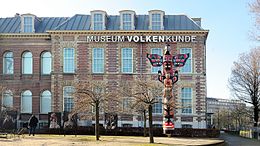Reich Museum of Ethnology
The Museum für Völkerkunde in Leiden ( Dutch: Museum Volkenkunde , also Rijksmuseum voor Volkenkunde ) was the first ethnological museum in Europe and, with its well-documented, famous collections, enjoys a great international reputation to this day.
Building the stocks
King Willem I of the Netherlands (1772–1843) had already set up a cabinet with Chinese rarities in 1816 , which in 1821 was incorporated into a newly created Royal Cabinet of Rarities. In 1826 the collection was bought by Jan Cock Blomhoff (1779-1853), who had managed the Dutch trading post Dejima ( Nagasaki ) from 1817 to 1823 . In 1832 the collection brought together by Johannes Gerhard Frederik van Overmeer Fischer (? –1848) in Japan was added. Then the doctor and Japan researcher Philipp Franz von Siebold (1796–1866) , who had returned from the Far East, brought in his treasures. During his stay in Japan (1823–1829) in the service of the Dutch East India Company (Vereenigde Oostindische Compagnie), he collected a wealth of natural and ethnological objects. A large part of this, together with the previously acquired collections, now formed the basis of the museum founded in 1837. In 1903 the museum also took over the extensive ethnological collection of the Rijksmuseum van Outheden .
Today the museum preserves objects from Africa , Greenland , China , Indonesia , Japan , Korea , Latin America , North America , Oceania and large parts of Asia.
See also
literature
- Topstukken van Rijksmuseum Volkenkunde . KIT Publishers, Amsterdam 2013, ISBN 9789460222535
- Rudolf Effert: Royal cabinets and auxiliary branches: origins of the National Museum of Ethnology, 1816-1883 . Leiden 2008, ISBN 978-90-5789-159-5
Web links
- Official (English, Dutch)
- Rijksmuseum Volkenkunde In: holland.com (German)
- Museum Volkenkunde In: visitleiden.nl (German, Dutch, English)
Coordinates: 52 ° 9 ′ 49.7 " N , 4 ° 29 ′ 3.1" E
